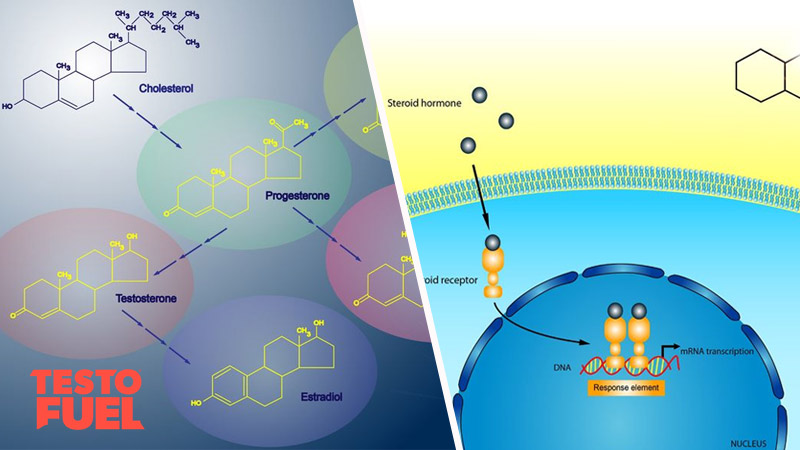TestoFuel Blog : Make Gains & Pack on the Muscle

The physiology behind your primary male hormones is quite complex. But the more you understand about testosterone, the easier it is to harness its power.
If you want to learn more about how androgens such as T affects your body and how it functions inside of your cells then you’re in the right place.
Here’s what we’ll cover:
Testosterone (T) is a sex hormone and natural anabolic steroid. It is plays a key role in making you a man.
T is responsible for the regulation and maintenance of your reproductive system by controlling spermatogenesis – the creation of sperm. It also plays a primary role in ensuring reproductive tissues such as your testes and prostate develop effectively.
This natural steroid is also responsible for secondary sex characteristics such as the stimulation and maintenance of muscle and bone mass, maximal strength and athleticism too
And not only that but it regulates body hair, how deep your voice is and how masculine your personality and overall demeanour is as well.
The process behind how T is released in to the bloodstream is fairly complex and involves many different hormonal feedback loops, as regulated by the hypothalamic-pituitary-gonadal (HPG) axis.
The journey from the hypothalamus to the testes is a bit like a relay race, with each individual athlete being responsible for a specific course (or in the case of T production, a part of the HPG axis). But without the baton being passed on from the previous athlete it can’t do its job.
It is a complex system but also really important.
All hormones can be classified by their chemical structure.
Peptide hormones for example such as insulin and growth hormone are made up of chains of amino acids.
Steroid hormones on the other hand are not made up from proteins but instead are derived from lipids – cholesterol.
As an important precursor to T, cholesterol goes through a complex conversion inside your testes to get to T.
In order to convert into it, cholesterol is converted into pregnenolone by an enzyme called cytochrome P450. From there it converts into other hormones such as androstenedione, eventually ending up as T.
Other steroid hormones include estrogens, glucocorticoids and progestins as well as testosterone.
Testosterone is the primary male hormone. And as a hormone it has a direct influence over what happens on a cellular level, acting as a chemical messenger to your cells.
But whilst T can reach all of the cells in your body, it can only have an effect on those with androgen receptors (AR).
What are androgen receptors?
ARs are proteins that work a little bit like baseball mitts, safely catching testosterone and transporting it to the cell. The actual technical name for this process is a little more scientific though – steroid-hormone activated transcription factor [1].
Otherwise known as NR3C4, androgen receptors are a family of proteins that facilitate the effects of T on your cells.
Your androgen receptors are present throughout various tissues. These include your prostate, skeletal muscle, liver, and central nervous system (CNS) [2].
Once T has entered the bloodstream via the testes, it travels to whichever target tissue is its destination. It is then taken but by the corresponding AR.
Once inside the cell, testosterone functions by binding with the androgen receptor protein that enters the nucleus and activates specific genes.
Once T binds to the androgen receptor it changes its own structure. That’s because until it does so it’s a square peg in a round hole – it just won’t fit.
But by changing its structure it is able to wriggle into the nucleus of the cell and then bind to a DNA sequence known as a hormone response element. This essentially helps it regulate changes to your genes [3].
The result is that T can bring around specific changes to that cell and therefore play out its androgenic role – it can make your body hair grow, your muscles bigger and your voice deeper.
It’s worth noting as well that ARs have other roles aside from DNA transcription. They are also involve in development and maintenance of sexual characteristics, traits and behaviour too for example.
Key Point: Androgen receptors have the vital role of letting testosterone into the cell so it can have a direct influence on your genes and the DNA within them.
Testosterone is responsible for developing and maintaining both primary and secondary sex characteristics. It keeps you strong, muscular and fit but also boosts your masculinity too – it keeps you assertive, commanding and manly.
But T can’t play out its role without androgen receptors allowing it access into your cells, through to your DNA and letting it do what it does best. Androgen receptors have the vital role of letting T into the cell so it can have a direct influence on your genes and the DNA within them.
To truly harness the power of testosterone you need TestoFuel – a premium grade hormone boosting complex.
Using only natural nutrients such as D-aspartic acid, vitamin D and zinc, this top-of-its-class supplement will take your training to the next level.